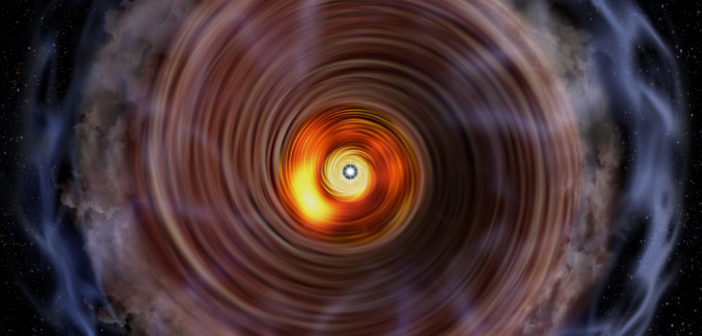Research reveals surprising influence of the magnetic field and gravity in massive star formation

The research team, that includes an IEEC researcher, discovered that high-mass star formation can occur also in weakly magnetized environments
A new study published in The Astrophysical Journal Letters reveals how magnetic fields and gravity affect high-mass star formation processes. The team, which includes the researcher Josep Miquel Girart from Institute of Space Studies of Catalonia (IEEC — Institut d’Estudis Espacials de Catalunya) at the Institute of Space Sciences (ICE, CSIC), used the Atacama Large Millimeter Array (ALMA telescope) to tackle the role of the magnetic field in the high-mass star formation process.
They observed a source called IRAS 18089-1732, a star-forming region 7600 light-years away, and found a well-organized magnetic field that resembles a spiral “whirlpool”. Until now astronomers only had a limited amount of observational evidence to prove or disprove the influence of the magnetic field on star formation.
 Caption: Magnetic field in the massive star-forming region IRAS 18089-1732
Caption: Magnetic field in the massive star-forming region IRAS 18089-1732
Credits: ALMA
Contrary to the model predictions, the magnetic field appears overwhelmed by another of the four fundamental forces in nature, gravity. Research reveals that gravity can shape the gas morphology and dominate the energetic balance.
In addition, the study has revealed that the magnetic field lines are twisted because of the gas gravitational movement. In conclusion, the study shows that high-mass star formation can occur also in weakly magnetized environments, with gravity taking the dominant role.
This discovery reveals the diversity in which high-mass stars form and comes to the unexpected conclusion that high-mass stars can be born in either strongly or weakly magnetized environments.
These observational results were published in The Astrophysical Journal Letters on June 30, 2021. The article has been featured in AAS Nova, which includes research highlights from the journals of the American Astronomical Society. Josep M. Girart is the second author of the study led by Patricio Sanhueza of the National Astronomical Observatory of Japan (NAOJ).
Links
More information
This research is presented in a paper entitled “Gravity-driven Magnetic Field at ~1000 au Scales in High-mass Star Formation”, by Patricio Sanhueza, Josep Miquel Girart et al., which appeared in the journal The Astrophysical Journal Letters on 30 June 2021.
The Institute of Space Studies of Catalonia (IEEC — Institut d’Estudis Espacials de Catalunya) promotes and coordinates space research and technology development in Catalonia for the benefit of society. IEEC fosters collaborations both locally and worldwide and is an efficient agent of knowledge, innovation and technology transfer. As a result of 25 years of high-quality research, done in collaboration with major international organisations, IEEC ranks among the most noted international research centers, focusing on areas such as: astrophysics, cosmology, planetary science, and Earth Observation. IEEC’s engineering division develops instrumentation for ground- and space-based projects, and has extensive experience in working with private or public organisations from the aerospace and other innovation sectors.
IEEC is a private non-profit foundation, governed by a Board of Trustees composed of Generalitat de Catalunya and four other institutions that each have a research unit, which together constitute the core of IEEC R&D activity: the University of Barcelona (UB) with the research unit ICCUB — Institute of Cosmos Sciences; the Autonomous University of Barcelona (UAB) with the research unit CERES — Center of Space Studies and Research; the Polytechnic University of Catalonia (UPC) with the research unit CTE — Research Group in Space Sciences and Technologies; the Spanish Research Council (CSIC) with the research unit ICE — Institute of Space Sciences. IEEC is a CERCA (Centres de Recerca de Catalunya) center.
Contacts
IEEC Communication Office
Barcelona, Spain
Sònia Bagudanch
E-mail: comunicacio@ieec.cat
Lead researcher in IEEC
Barcelona, Espanya
Josep Miquel Girart
Institute of Space Sciences (ICE, CSIC)
Correu electrònic: girart@ice.csic.es
